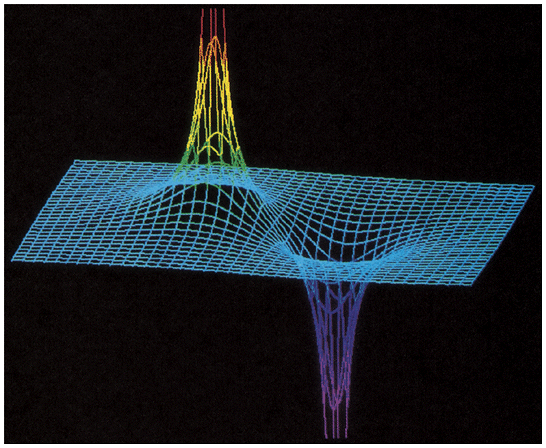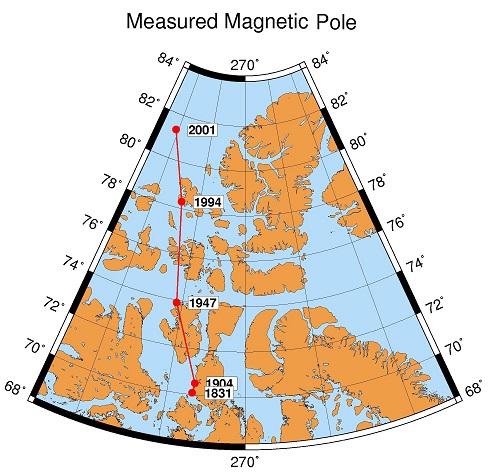



|
| About Marshall Future Students Current Students Alumni Faculty/Staff |



|

|
|
|||||
|
PS.122 Links:
» Syllabus
- Off-Campus Sites -
» physicsforums
|
Physics For Teachers (PS.122 - §203, 2018 Spring => CRN 4619)
Class Meets in : Science 179 ... Tue & thRs 3:00pm - 4:50pm My office: Science 159 (below ramp to 3rd Ave) e-mail : foltzc @ marshall.edu phone : (304) 696-2519 Topic 5 (Electricity & Magnetism)where we re-do the first 4 topics, but watch electric charge, rather than massQuiz 5 was Tue.Apr.03 . . . here is my grading key as *.jpg imageElectric charge comes in TWO kinds : Positive (protons) and Negative (electrons) ... the total is conserved !
Protons are hidden deep inside an atom, in the nucleus ... electrons are smeared (cloud-like) around that nucleus
| |||||||||
 | here's a 2-dimensional graph of the Electric Potential (vertical axis)
near a positive charge (left) and a negative charge (right) everywhere on the left half has positive Potential V = 0 all along center-line , midway between the charges
|
Power : the rate that charge carries Energy
A fresh battery has a lot of (+) PE because it has excess protons (+q) near the (+)V end,
and also a lot of excess electrons (−q) near the (−)V end.
. . . in use, electrons leave the (−)V end with (−e)(−V) = (+)PE,
and eventually enter the (+) end with (−e)(+V) = (−)PE .
It is the difference in potential (one end − the other) that is the voltage, which describes the "electrical landscape".
the Electric Field is the gradient (slope, distance-wise) of the potential , so that's what determines how fast the charge flows.
. . . connect a really long wire to both sides of a battery, and the potential gradient along it will be very shallow, so very slow current
connect that drop via a short route, and the current might be so fast as to melt its insulation off!
. . . if there are 2 routes from high PE to low PE, some charge will take each route ... more will take the steeper or wider wire
the shorter wire with big Area conducts well , so it presents low resistance to charge flow.
. . . if there are 2 obstacles (light bulbs) in a path (from high to low), the 2 voltages ("electric height" drops) must add to be the total voltage
current will flow ½ as fast (I = ½ I1) because each bulb (filament length) can only be half as steep ... since their voltages add.
=> I = V /R . . . where R is the Resistance to flow ... "obstacle-ness" ... Resistances in series add ... since the same current flows thru both bulbs!
sort-of-optional: more about electrical resistance
You may think of resistance as electric friction, transforming electric PE into Thermal TE
the faster the current goes thru, the faster the Energy gets "lost to friction" ... since Power = ΔE/Δt ,
=> Power = I·V . . . Watt = Amp·Volt .
resistance depends on the length of the conductor × how hard that kind of material is to go thru
. . . conductance ... 1/resistance ... depends on the Area that the electrons can go thru
=> R = resistivity * L / A . . . resistivity is a material property (look up in a table) but it changes with Temperature
Resistances in series add ... because their lengths add
2 resistors in series exert 2× the resistance (to current flow) as one did
. . . resistances in parallel are reduced ... conductances in parallel add ... because their Areas add
3 resistors in parallel exert 1/3 as much resistance as one did
Opposite poles attract ; like poles repel
. . . a compass is a small bar magnet on a pivot;
its magnetic North pole is labeled with "N" ... attracted to Magnetic South poles
. . . compass "N" points geographically Northward - toward Canada
=> "Magnetic South" pole is underneath Canada (magnetic North is below AntArtica)
Electric current flowing ccw around a coil makes a magnetic field
. . . magnetic field is most intense up thru the inside of the coil Area
same number of loops down around the coil outside, but spread farther
. . . single current loop has one North face and one South face
field looks just like a "button magnet" field
. . . second current loop in the same sense (cw/ccw) adds to that field
(current loop in opposite sense cancels it)
. . . coil wrapped around iron core can be 100's of times as strong.
If you break a magnet, and pull the 2 pieces apart,
. . . a new "South pole" and a new "North pole" appear in the middle.
. . . the "ends" of a magnet are not really the source for the Magnetic field
=> the entire magnetic material is the source for the Magnetic Field
each atom is a tiny magnet ... the valence electron orbits are most important
but each proton is a magnet, each neutron is a magnet, each electron is a magnet)
. . . the electron's orbit axis can re-orient ... in a magnet, the orbits align along their neighbors' orbits
. . . their magnetic fields re-inforce one another ... add together constructively
(c.f: when electric dipoles align, their Electric fields tend to cancel)
=> there is no such thing as an "isolated magnetic pole" ... always magnetic field pointing along an axis
Magnetic field intensity decreases with distance
(as their field spreads, of course!)
. . . an object magnet will tend to turn ... when a subject magnet approaches
so that its opposite pole is nearest the subject's approaching pole
. . . so magnets turn each other in a way that they will attract one another
but the source dipole partly cancels, and the Force partly cancels
=> magnet-to-magnet Force goes as ~ 1/distance to the fourth
so magnets aligned oppositely will attract each other from the side
and magnets aligned alike will attract each other from either end.
generator: mechanical Energy input, turns a permanent magnet
. . . this pushes the (conduction) charges along a (wire) coil
which "seem to be moving" , relative to the turning magnet
. . . while the magnetic pole tip sweeps across the coil material
(that is, when their torque is maximum)
. . . the current flows from the coil carrying electric Power
as (−) charge at (−) electric potential.
. . . some motors can also be used as a generator
. . . some generators can be used as a motor
=> "hybrid" cars can "brake" by having their magnets push charge into their batteries
transformer: a "generator" that uses an electro-magnet input, instead of a permanent magnet
. . . many-loop coil (input) makes intense magnetic field even with small current
(its long wire impedes current, even if the voltage is high)
. . . few-loop coil at output has lots of current, even if not much voltage
it is the number of loops that determines the voltage
. . . Power in ≈ Power out ; they are often over 90% efficient
wall : 0.2 Amp · 120 Volt = 4 Amp · 6 Volt , at battery
a transformer requires changing current ... so they do not work with DC ...
. . . some DC-DC converters make their input current change
by "switching" the input circuit on and off
 | here's a map of where the Magnetic South Pole has been
. . . wandering around the North geographic (spin) pole it has been moving much faster than usual, recently . . . it has been getting less intense, also recently mostly because it seems to be fragmenting South pole and North pole "switch" routinely in the geologic record . . . on average, every half million years it is over-due to reverse again . . . since the last reversal was ¾ million years ago. |
| maintained by Curt Foltz - email comments to foltzc@marshall.edu
... all my pages are copywrite as "Fair Use" (name me as source) my pages don't use cookies, or collect any info from your browser but read this Privacy Policy for info on "www.marshall.edu" pages. | Marshall University
One John Marshall Drive Huntington, WV 25755 (304) 696-3170 | A-Z MU site index
MU Academics MU Calendars financial aid |